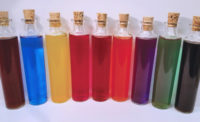When it comes to food, and especially candy, flavor is king. It’s a fact that the industry understands well — if it doesn’t taste good, consumers won’t eat it.
At the same time, says Bill Vlach, food technologist for Cargill’s Cocoa & Chocolate team, consumers are experience-driven and willing to try creative products with unique flavors.
“When it comes to chocolate, consumers have time-tested favorites, so it’s all about balancing the classics and new, exotic flavors — familiarity with excitement,” he says. “Incorporating healthy inclusions like pomegranates, chia seeds, exotic nuts, and tropical fruits allow consumers to ‘dip into the waters’ of new food items within the comfort of a known friend — chocolate.”
Manufacturers use this to their advantage, pairing more exotic ingredients like Himalayan pink sea salt with confections. Citrus flavors have expanded to include lesser-known fruits like blood orange, yuzu, Persian lime, and calamansi.
Super seeds like chia and hemp are also making their way into confections, offering unique tastes and textures. And for adults, new alcoholic flavors such as stout beer, bourbon, and whiskey are also becoming popular.
And the pace for innovation is increasing, says Jackie Anderson, a spokesperson for ADM’s Wild Flavors. Inspiration for those new and untapped flavors are more diverse than ever.
“That inspiration is coming from culinary and chef-created foods, exotic regional foods, and new combinations like vegetable or meat-flavored confections,” she says. “Pairings like bacon and caramel or smoky and spicy flavors are answering the desire for ‘something more.’”
In the digital environment in which we live today, consumers are much quicker to adopt new flavors and judge their merits. Companies have to be more nimble and adaptable than ever to sell to consumers in today’s market, says Anderson.
But exotic new flavors aside, consumers are seeking authenticity.
“Consumers want their natural flavors to taste real. They don’t just want a generic lemon; they want a Meyer lemon and they know what that should taste like,” Anderson adds. “The challenge to the flavorist is meeting these more sophisticated and knowledgeable expectations.”
The growing desire for confections that are all-natural, non-GMO, and better-for-you shows that attitudes toward sweets are changing.
Candy used to be a consumable, expendable income item eaten for pure enjoyment, says Cindy Cosmos, senior flavor chemist for Bell Flavors & Fragrances. But increasingly, there’s a desire for it to be more than that. And as consumers are driven to want all-natural ingredients, flavorists find their options for creating unique flavor profiles limited.
Some of the emulsifiers or solvents used to create well-known flavors simply aren’t available in a form that can be labeled all-natural, says Cosmos. The number of compounds flavorists can use are limited by these demands, which makes it harder to fit certain flavors into the candy matrix.
Solubility issues also arise. Some natural flavors are soluble only in a water base, she says, but when those same flavors need to be incorporated into an oil base, it’s a challenge — especially when certain emulsifiers can’t be used.
“Some things in nature can’t be changed,” Cosmos explains. “In those instances the challenge is what to use that is clean label and acceptable to provide the emulsification to a different solubility.”
But the main issue is cost. Raw materials from a natural source require more processing, and requirements to meet the non-GMO claim. And, the more you process it, the more the price goes up.
While it doesn’t always affect the taste, any time you process a confection with a flavor, you incur flavor loss, says Cosmos, which is the last thing you want if you’re working with an expensive flavor.
Ultimately, the key is to find compounds that will provide flavorists with what they can use in creating the right profiles. And it’s important to understand how the ingredients used will impact the final product.
“Before embarking on new product development, formulators need a clear understanding of the ingredients they will be pairing, the sensorial qualities of the targeted flavor as perceived by the customer, and how the pairing will impact viscosity, cost and shelf life,” says Vlach.
If an inclusion is added directly to the chocolate, the viscosity will increase. But if the flavors are used in a ganache or filling, the chocolate itself won’t be affected.
A more complex recipe with multiple ingredients and inclusions, however, will affect production time and labor costs, which are calculated into the final price of the finished product.
And shelf life can also be affected by certain types of inclusions.
“Any water-based ingredient, such as a fruit puree or cream-based ganache, increases water activity,” he says. “Water activity is a measurement of water available for microbial growth. As water activity in a confectionery center increases, the shelf life decreases.”
Which means it’s all a delicate balancing game to find the right combinations.
Cosmos, for one, is hopeful that as new flavor ingredients reach the FEMA approval list, options for developing more true-to-nature flavors will expand.
After all, as she says, natural, natural, and more natural will continue to reverberate in all confections.








